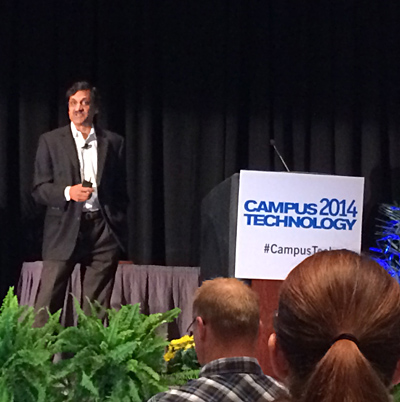Campus Tech 2014: Reinventing Higher Education

Photo: Tara E. Buck
The 3 billion — and counting — data records produced within the edX MOOC platform are providing educators around the globe with insights into how students learn best and how they prefer to learn, edX CEO Anant Agarwal told attendees at the Campus Technology conference on Wednesday.
Agarwal is a professor of electrical engineering and computer science at Massachusetts Institute of Technology, and he taught the first edX course in circuits and electronics, in May 2012. Since that time, the nonprofit, massive open online course (MOOC) provider has attracted more than 50 institutions as partners and 2.5 million students from every country in the world, Agarwal said in his morning keynote. The edX platform itself is free and open and is seeing rapid adoption by many countries looking to host free and open courses in local languages. France, China and Jordan are among those nations now offering open education opportunities through sites built on the edX platform.
“Already, in the space of a year, the open-source platforms around the world have more than 1 million students on them,” Agarwal said. “This federated, decentralized approach is really spreading education all over the world.”
While opening education and improving access and quality are top platform goals, Agarwal also shared how edX can be leveraged within a blended learning environment to improve student success rates and glean greater insight into student behavior and learning preferences.
“Everything around us has changed. Communication has changed, healthcare has changed, but education hasn’t,” Agarwal said. “It is actually pretty shocking and pathetic that the way we educate learners hasn’t changed in hundreds of years.”
“Students today want to be completely flexible,” he continued, “yet we insist on teaching them the same way that we have.”
EdX data give researchers the opportunity to perform A/B testing and engineer solutions to improve the quality of education over time, Agarwal said. “We can improve education through such research.”
“A lot of MOOC aficionados talk about these radical methods, and in many ways they are radical, but they’re not new. Many of these concepts — active learning, peer learning and instant feedback — have been researched by educators 20, 30, 40 years ago. What is new is applying the technology and making these ideas more scalable and available.”
Active Learning
EdX courses replace the traditional lecture with a learning sequence, and the platform’s user interface reflects this style of learning. Brief five- to six-minute videos are interwoven with exercises, and professors can also ask students to participate in discussions on specific topics related to the sequence.
Self-Based Learning
Students are able to watch lessons and videos when they want, and they appreciate such flexibility, Agarwal said. Videos can be paused, played back and watched as many times as necessary for a student to successfully understand a concept.
Instant Feedback
Agarwal believes edX offers greater opportunity for online assessment beyond simple multiple choice.
“We can create chemical equations on our platform, require image responses. We can grade using essays.”
Machine learning and artificial intelligence are contributing to the evolution and growth of assessment types online, according to Agarwal.
“This makes learning very much like a video game, where instant feedback is one of the most powerful components of gamification,” he said.
Such technology is also advancing virtual laboratory and experimentation opportunities for students.
Peer Learning
Many students cement their understanding of a concept or a sequence by explaining it to other students within a discussion forum. EdX professors can introduce discussions alongside every exercise or video within a course, Agarwal said.
“Many professors ban tablets and smartphones in classes today. We’re saying, ‘No! You should be using these tools to discuss things.'”
While edX is leveraging such learning concepts to improve online learning, Agarwal said that campus-based education and instruction can benefit from the incorporation of edX courses in a blended model.
Agarwal shared some preliminary findings from the fall 2012 edX blended learning pilot program set up at San Jose State University. A circuits and electronics course with an average failure rate of about 40 percent dropped to 9 percent when edX coursework supplemented in-class instruction.
The pilot has since been expanded to 11 other institutions within the California State University system.
At MIT — “where messing with things is in the DNA,” Agarwal joked — officials are transforming the campus and bringing the blended learning model to 23 classes and 2,800 students.
A solid-state chemistry class, led by professor Michael Cima, incorporates the idea that the entire course is a continuous exam.
“He said, ‘Here’s the work you have to do. You can come in and solve these problems online. When you’re done solving these problems, you’re done.’ And students can work on them whenever they want.”
After the fifth week of the course, when freshman are flagged, or notified about any course in which they’re performing poorly, Cima saw freshmen flag numbers fall from 20 (out of 400 to 500) in 2012 to only two in 2013.
Big Data
Since its launch, edX has amassed 3 billion records of student events, offering educational researchers myriad opportunities to learn more about student behavior and outcomes, in highly specific ways.
“We can capture every answer entered. We know what they’re doing at what time. What country they come from. We can look at what a student did to get an answer,” Agarwal said. “We know what parts of the learning experience contribute to successful outcomes, and whether that’s tied to certain kinds of students. We are using this to learn how students learn.”
One clear lesson has involved transforming traditional lectures into online video modules. Agarwal said that professors at first fought back on cutting short their 50- to 60-minute sessions; however, studies and other tests show that the median time students spend watching such videos is six to nine minutes.
“Now we can show them the data and say, ‘If you really want to improve the outcomes, keep the video short.’”
“We see the edX platform and the blended-learning model as a new tool to be used as much or as little as instructors please,” Agarwal said. “The last time we gave teachers a new tool was 1862: a piece of chalk and a chalkboard.”
The 21st annual Campus Technology conference runs through July 31. For more information, follow our event coverage here or visit http://www.campustechnology.com/summer.









